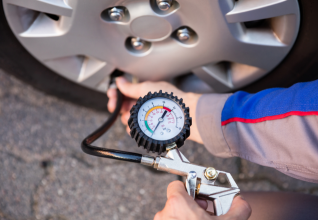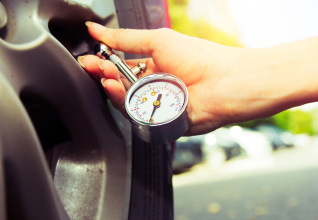Did you know that a mere 10% drop in tyre pressure can result in a 2.5% decrease in fuel efficiency? Tyre pressure isn’t just about the longevity of your tyres; it’s about safety, performance, and even your pocket. Let’s delve into the intricacies of tyre pressure and why it demands your attention.
Tyre pressure is the air in your car’s tyres, commonly expressed in PSI, bar, or kilopascals (kPa). This pressure is crucial for various factors, including safety, performance, and fuel efficiency. So, when should tyre pressure be checked? Let’s dive into it.
Importance of Correct Tyre Pressure
How Tyre Pressure Affects Safety
Driving safely is paramount, and tyre pressure directly affects this. When properly inflated, tyres can offer the highest traction and responsiveness, greatly enhancing the vehicle’s handling characteristics.
On the other hand, if the tyre pressure is too high or too low, it may affect the tyre’s grip on the road, increasing the need for more time to stop, making it harder to turn and, in extreme situations, leading to blowouts or unexpected tyre failure.

How Tyre Pressure Affects Performance
The performance of your car is significantly impacted by tyre pressure and safety. The performance also includes how well your car reacts to your inputs, not just how fast it can go.
No matter the road conditions, a car with properly inflated tyres will be responsive, handle well, and provide a smooth and comfortable ride.
On the other hand, improper tyre pressure can result in uneven wear, a harsh ride, and early replacement.
How Tyre Pressure Affects Fuel Economy
You might be surprised to learn that your tyre pressure can impact your car’s fuel efficiency. Your vehicle’s rolling resistance rises as a result of underinflated tyres.
Your car must exert more effort and consume more fuel to keep moving at the same pace. You may save money on fuel and lessen your carbon footprint by maintaining the proper tyre pressure.
Understanding Tyre Pressure Units
Tyre pressure is typically measured in pounds per square inch (PSI), but other units like bar or kilopascals (kPa) are also used, especially in different parts of the world.
When monitoring the pressure in your tyres, it’s crucial to be familiar with these units. Furthermore, it’s important to know the required tyre pressure for your particular automobile, which may be found in the owner’s manual or on a sticker attached to the driver’s side door jamb or fuel filler cap.
When Should Tyre Pressure Be Checked?
Regular Routine Checks
One of the most common questions motorists ask is, “When should I check my tyre pressure?” Generally speaking, you should check your tyre pressure at least once each month. Your tyres may still have a gradual leak even if they appear to be in good condition. Regular inspections assist in identifying these slow leaks, allowing you to remedy them before they worsen.
Seasonal Changes
Did you realise that fluctuations in temperature can impact the pressure in your tyres? Generally speaking, your tire’s pressure will change by around 1 PSI for every 10 degrees that the temperature changes. Due to this variation, your tyre pressure checks should alter with the seasons. When changing from summer to winter, and vice versa, it is crucial to check your tyre pressure.
Long Trips
It’s essential to check your tyre pressure before starting a long journey. Your tyres may heat up and lose pressure while you drive for a long time.
Furthermore, transporting extra weight—such as a boot full of luggage—can stress your tyres, increasing the likelihood of a blowout.
Before a long trip, check your tyre pressure to make sure your tyres are ready to take the added weight and extended driving.
After Tyre Repair or Replacement
If you have had a tyre repaired or replaced, check the tyre pressure. It’s crucial to adjust a new or patched tyre to the same pressure as the rest of your tyres because they might not have been inflated to the proper level. This constancy will provide even tyre wear and balanced handling.
How to Check Tyre Pressure

Necessary Tools
You’ll need a reliable tyre pressure gauge to check your tyre pressure. These come in various types, including digital and dial gauges, and can be purchased at most automotive stores. Some newer vehicles also come equipped with built-in tyre pressure monitoring systems (TPMS), alerting you when your tyre pressure is low.
Checking Procedure
First, ensure your tyres are cool because warm tyres expand under pressure. Checking your tyre pressure is ideal before driving in the morning or at least three hours later.
After that, open your tire’s valve cover and put the tyre pressure gauge on the valve stem. You will then receive a reading from the gauge. Take note of this reading, then contrast it with the tyre pressure the manufacturer recommends for your car.
Adjusting Tyre Pressure
Based on the manufacturer’s recommendations, you must change your tyre pressure if it is too high or too low. Release some air if it’s too high, and check again. If it’s too low, use a tyre inflator to add air until you get the right pressure. Once finished, don’t forget to replace the valve cap securely.
Key Takeaway
The right tyre pressure should always be maintained, even though it may seem simple and insignificant. Understanding when and how to check your tyres’ pressure can enhance your vehicle’s performance, security, and fuel efficiency. Make sure to incorporate it into your routine auto maintenance schedule to benefit your tyres, wallet, and the environment.
FAQ
